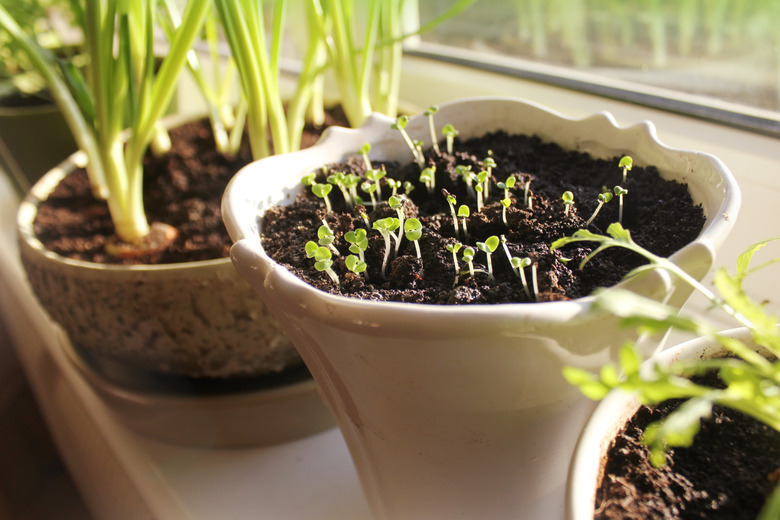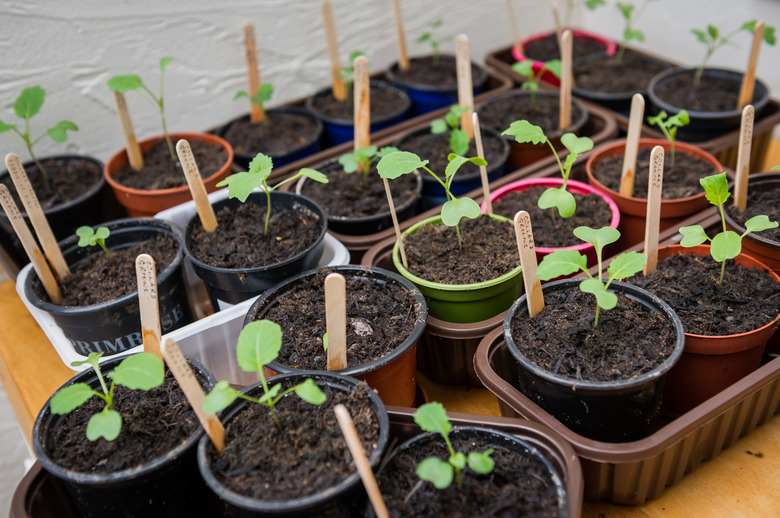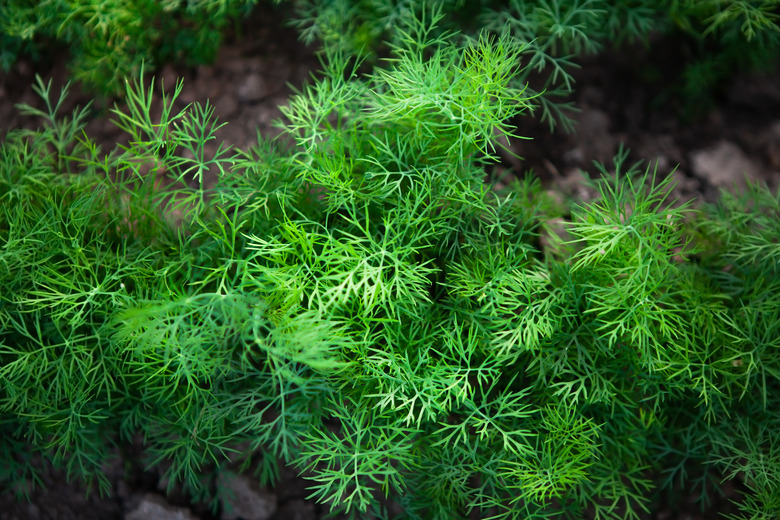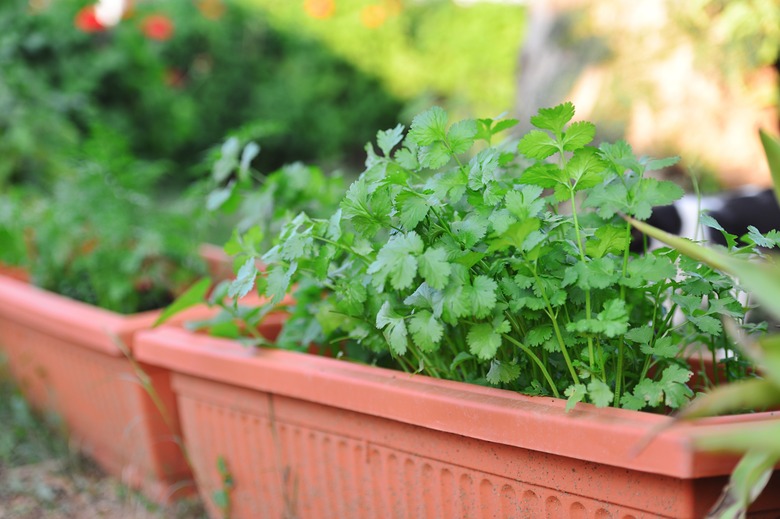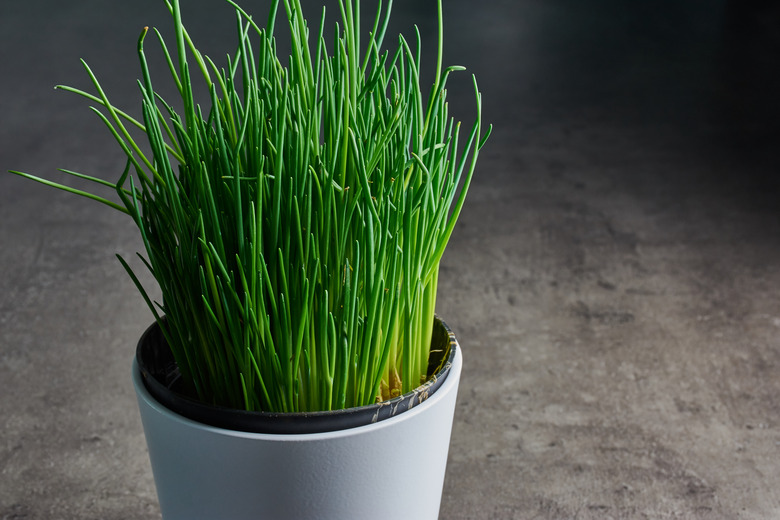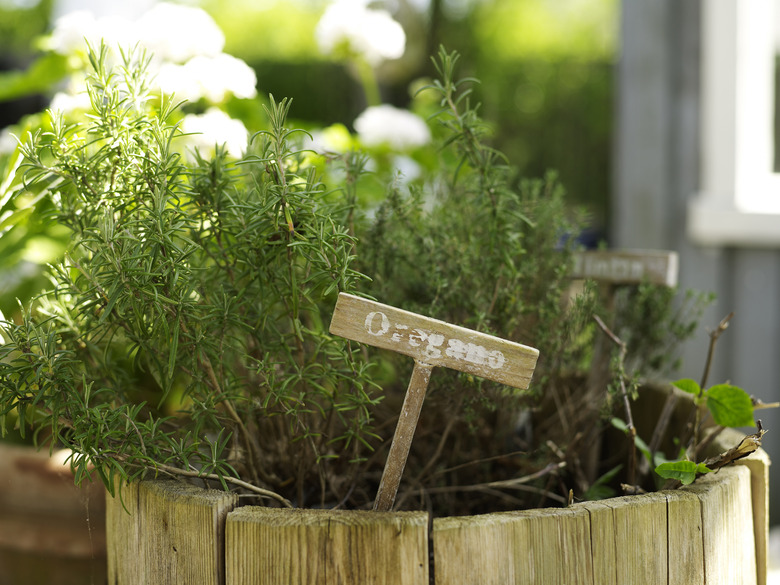How To Grow Herbs From Seed — And Which Ones To Choose
It isn't unusual to hear gardening enthusiasts warn that growing herbs is an addictive activity, but unlike many addictions, this is one worth having. Some herbs have medicinal qualities, some make delicious teas and all of them have a place at the table where they can add flavor to hot foods, garnish salads and pair with fruits and vegetables to make savory appetizers. Sure, you can buy herbs at the grocery store, but why do that when it's so easy to have top-quality basil or parsley fresh for the picking right in your own garden?
How to Start Herb Seeds
Although there is a general procedure for starting seeds, every herb has slightly different needs for timing, spacing, temperature and light, so it's definitely worth your while to do some research, including reading the information on each seed packet. Some examples of the differences you'll encounter include planting depth (oregano seeds need to be on the surface because they need light, whereas cilantro (seeds need to be buried) and timing (seeds that take longer to germinate should be sown earlier). Some seeds, such as cilantro, germinate more quickly if you soak them before planting, but that isn't true for all of them.
Here's how to properly start your herbs from seed:
1. Choose a Seed Starting Mix
Select your preferred seed-starting mix. You don't have to be too fussy about which seed-starting mix in which to sow the seeds as long as it's a good-quality one because it will work for all seeds. You can even make your own mix using peat moss or coconut coir, but many commercial mixes are sterilized, which is insurance against disease.
Avoid using a potting mix for starting seeds as it isn't a good substitute for seed-starting mix because it isn't as loose and might hinder development of the young roots. Potting mix is also richer in nutrients, which may cause seeds to rot. You won't need potting mix until after the young seedlings emerge, and you transfer them into larger containers.
Make the transplant easier on the young plants by starting the seeds in biodegradable containers that can be buried directly in the soil. Don't forget to label the containers because herbs are difficult to identify when they are very young. Plant the seeds at the recommended depth according to the seed packet.
Keep the seeds moist and warm, but the pots should have drainage holes that prevent the soil from staying wet, which can cause damping off and can kill the young seedlings. If the seeds need light to germinate, it's better to provide it with grow lights than to place the pots on a windowsill, where cold air can inhibit germination. The seeds need good air circulation, but they also need to stay warm. If the air is stagnant, one or two small fans are probably all you need to keep the air moving.
Harden off seedlings going into outdoor gardens by placing the pots in a wind-sheltered location in bright filtered or light shade. Set the pots out daily, starting at one hour and increasing the time until the seedlings are outside all day, then transplant the seedlings into the garden or outdoor containers.
Prepare a sunny garden bed by removing all plant debris, roots, rocks, and sticks, then digging in 2 to 3 inches of compost and other amendments according to a soil test. Alternatively, add a good potting mix to large containers. Wet the soil and potting mix thoroughly before transplanting the seedlings.
Tear off the upper one-third to one-half of the biodegradable pot so the exposed paper or peat doesn't wick moisture away from the seedlings' tender roots. Dig planting holes at the recommended spacing, generally at the same depth and twice as wide as the root balls and/or pots. Put the seedlings in the holes and backfill with the excavated soil. Tamp gently and water thoroughly; keep watering, daily if necessary, to keep the soil evenly moist but not waterlogged.
The Best Herbs to Grow from Seed
Not all herbs are easy to grow from seed; some are too slow-growing, and others don't emerge true to type and are better grown from seedlings. Despite these outliers, there's a long list of culinary herbs that you can grow from seed and have a great time doing it. Some are annuals that you'll have to replant every year, but a good many are perennials that will keep producing year after year once established as long as you provide the proper TLC. Here are our favorite herbs to grow from seed:
1. Dill
One of the annual herbs, dill (Anethum graveolens) has feathery, fragrant leaves collectively known as dill weed that are used to flavor a variety of dishes, particularly fish, and savory seeds that give dill pickles their characteristic tang. The plant has a long taproot that does not take well to transplanting, so it's best to sow dill seeds in the place where you want the plant to grow, which can be a garden bed or a container. You can also sow the seeds in small, degradable pots that you can plant directly in the earth as soon as the seedlings have their second set of true leaves.
Dill grows best in full sun and likes nutrient-rich soil that is slightly acidic, with a pH between 5.8 and 6.5. Sow seeds 1/4 inch deep and 6 inches apart and thin seedlings when they emerge to increase the spacing to 12 inches. The plants take about 90 days to mature after seeding, so if you start seeds outdoors right after the final frost, you'll be able to begin harvesting by midsummer.
Cilantro (Coriandrum sativum) is an annual that prefers cool weather, and it tends to bolt (flower prematurely) when exposed to the hot summer sun, so it's a plant you'll either want to keep in the shade or plant in mid to late summer for a fall harvest. The spicy leaves are a mainstay in salsa, curry and Asian soups, and the ground seeds, which are known as coriander, confer a musky, lemony taste to curries and stews. One of the fastest-growing herbs, cilantro can mature in as few as four weeks after sowing the seeds.
The seeds need to be buried 1/2 inch in the soil, which is deeper than most herb seeds, and you should avoid transplanting the seedlings to prevent bolting. Germination occurs 10 to 15 days after the seeds are planted, and the seedlings should be thinned to 4 inches apart when they are 2 inches high. Cilantro will self-seed, but you'll want to collect at least some of the coriander seeds for use in the kitchen. The ones you let fall in the ground will produce a new crop.
One of the perennial herbs, chives (Allium spp.) will thrive outdoors in USDA zones 4-8 and in containers indoors in more northern zones. A member of the amaryllis family (Amaryllidaceae), chives are nowhere near as overpowering as their onion relatives in this same family. They add a delicate spiciness to soups and salads and are a familiar garnish for baked potatoes. Chives grow in clumps like tall grass, and each blade produces a round, purplish flower that attracts beneficial insects and is also edible.
Chives need four to six hours of sun per day and can tolerate some shade, and some species, such as garlic and onion chives, are good herbs for growing indoors. When growing them outdoors, seeds should be started indoors four to six weeks before the last frost in well-draining, rich, moist soil and transplanted when they are 4 to 6 inches tall. The seeds should be sown 1/4 to 1/2 inch deep and will germinate in 14 days at a temperature of 70 degrees Fahrenheit.
Four clumps will satisfy the culinary needs of most households. The mature plants go dormant in the winter in colder climates while remaining evergreen in milder climates. They can tolerate temperatures as low as -35 degrees, and they spring back to life in the spring to provide a harvest by midsummer.
Populating different genera, such as Origanum and Plectranthus, different oregano species grow as perennials in zones 3 through 10, depending on the species you're growing. In many climates, however, they are better grown as annuals. The peppery, somewhat astringent taste is good for stews, poultry and pizza, and it's a mainstay in Greek salads and other Mediterranean dishes.
Oregano seeds are tiny and need light to germinate, so they should be sown on the surface of the soil and gently pressed in to make sure they are in good contact. When sowing seeds indoors for transplanting outdoors, place the seeds in starter trays under grow lights a good six to eight weeks before the last frost date. The young plants need at least six hours of direct sun, and they grow rather slowly, so be patient. You may have to wait four weeks before planting them in your garden bed.
No herb garden is complete without sweet basil (Ocimum basilicum), a necessity if you want to make pesto or garnish your mozzarella, tomato and olive oil appetizer. Seeds germinate in only five to 10 days, and when grown in full sun and on loamy soil, these annual plants quickly produce licorice spice leaves that are tastiest when they're young. Some other fresh herbs you can grow from seed include:
- Fennel (Foeniculum vulgare)
- Lemon balm (Melissa officinalis)
- Chervil/French parsley (Anthriscus cerefolium) and parsley (Petroselinum crispum)
- Chamomile (Chamaemelum nobile)
- Summer savory (Satureja hortensis)
- Sage (Salvia officinalis)
- Marjoram (Origanum majorana)
Because they either grow too slowly or don't grow true from seed, it's better to start these herbs from store-bought seedlings:
- Thyme (Thymus spp.)
- Lavender (Lavandula spp.)
- Mint (Mentha spp.)
- Rosemary (Salvia rosmarinus)
- Lemon verbena (Aloysia citriodora)
- Bay leaf (Laurus nobilis)
- Tarragon (Artemisia and Tagetes spp.)
The reason you don't want to grow herbs in the second group from seed isn't because you can't do it; it's just because it isn't worth the time and effort you'll have to devote, and in the case of certain types of mint, the seeds won't produce the plants you expect.
How to Care for an Herb Garden
Though herbs are generally pretty easy to care for (particularly when compared to finicky flowers), there are a few things to keep in mind when caring for them:
1. Don't Use Pesticides
When the young seedlings emerge in your herb garden, they are particularly vulnerable to insect pests. One of the most important benefits of growing herbs from seed rather than purchasing seedlings is that it's possible to ensure the entire process is organic, from seed to full maturity. You don't want to spoil that by using a pesticide.
Once the seedlings have emerged, most of the hard work is over, and you just have to make sure the plants get the light, water and nutrients they need to thrive. Most herbs need full sun to thrive, so if you put them outdoors in the garden, be sure they aren't being shaded by taller plants. A few herbs tolerate as little as three to four hours of direct sunlight daily, including:
- Chives
- Cilantro
- Oregano
- Parsley
Annual herbs, like basil and dill, can be planted alongside vegetables and flowers; basil is especially compatible with tomatoes and peppers, whereas dill pairs well with cucumbers, lettuce and onions. Perennials, like chives and oregano, are best grown in dedicated herb gardens, although chives make a good edging for your flower garden and oregano makes a good ground cover.
One of the great things about growing herbs is that they produce throughout the growing season, and the more you trim from some of them, the more they grow back. However, it's important not to let your leafy herbs flower unless you're growing an herb like coriander or cumin for the seeds. Once leafy herbs, like basil, produce flowers, they draw most of the plant's energy, and their pollen becomes more valuable to bees than the leaves are to your cuisine. So, trim liberally and enjoy.
